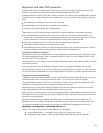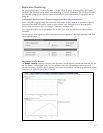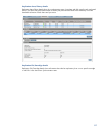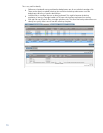
65
Replication and other D2D operations
In order to either optimize the performance of replication or minimize the impact of replication on other D2D
operations it is important to consider the complete workload being placed on the D2D.
By default replication will start quickly after a backup completes; this window of time immediately after a backup
may become very crowded if nothing is done to separate tasks. In this time the following are likely to be taking
place:
Other backups to the D2D system which have not yet finished
Housekeeping of the current and other completed overwrite backups
Copies to physical tape media of the completed backup
These operations will all impact each other’s performance, some best practices to avoid these overlaps are:
Try to schedule backups so that their finish times are co-incident, this may take some trial and error. If all
backups can run in parallel there is an overall aggregate performance increase and if they finish within a few
minutes of each other, the impact of housekeeping from the backup jobs will be minimized.
Delay physical tape copies to run at a later time when housekeeping has completed.
Set replication blackout windows to cover the backup window.
Set housekeeping blackout windows to cover the replication period, some tuning may be required in order to
set the housekeeping window correctly and allow enough time for housekeeping to run.
Replication blackout windows
The replication process can be delayed from running using blackout windows that may be configured using the
D2D Web Management Interface. Up to two separate windows per day, which are at different times for each
day of the week, may be configured.
The best practice is to set a blackout window throughout the backup window so that replication does not interfere
with backup operations.
If tape copy operations are also scheduled, a blackout window for replication should also cover this time.
Care must be taken, however, to ensure that enough time is left for replication to complete. If it is not, some items
will never be synchronized between source and target and the D2D will start to issue warnings about these items.
Replication bandwidth limiting
In addition to replication blackout windows, the user can also define replication bandwidth limiting; this ensures
that D2D replication does not swamp the WAN with traffic, if it runs during the normal working day.
This enables blackout windows to be set to cover the backup window over the night time period but also allow
replication to run during the day without impacting normal business operation.
Bandwidth limiting is configured by defining the speed of the WAN link between the replication source and
target, then specifying a maximum percentage of that link that may be used.
Again, however, care must be taken to ensure that enough bandwidth is made available to replication to ensure
that at least the minimum (2 Mb/s per job) speed is available and more, depending on the amount of data to be
transferred, in the required time.
Replication bandwidth limiting is applied to all outbound (source) replication jobs from an appliance; the
bandwidth limit set is the maximum bandwidth that the D2D can use for replication across all replication jobs.
The replication bandwidth limiting settings can be found on the D2D Web Management Interface on the
Replication - Local Appliance - Bandwidth Limiting page.
There are two ways in which replication bandwidth limits can be applied:
General Bandwidth limit – this applies when no other limit windows are in place.
Bandwidth limiting windows – these can apply different bandwidth limits for times of the day


















